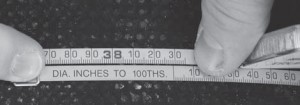
The diameter tape measure easily figures the diameter of a pipe or pipeline. All you have to do is wrap it around the pipe, and read off the diameter. Here are its mysteries..
-
- Why is the “zero” mark not at the beginning of the tape? It is a couple inches away from the beginning of the tape.
- Why does the end of the tape have a “loop” instead of a “hook”?
- Why are some calibrated in 100ths of an inch, and some in 64ths of an inch, and some in millimeters?
ANSWERS:
- By having the zero mark away from the beginning of the tape, you can easily line up the other part of the tape to the zero mark.
- Since zero is not at the end of the tape, there is no need to have a hook there. What is helpful, is to have a metal loop to hold onto, when wrapping the tape around the pipe.
- Different strokes for different folks. Automotive repair people prefer the 64ths of an inch calibration. Oilfield people prefer the 100ths of an inch version. And of course, some people use the metric system of measurement.

